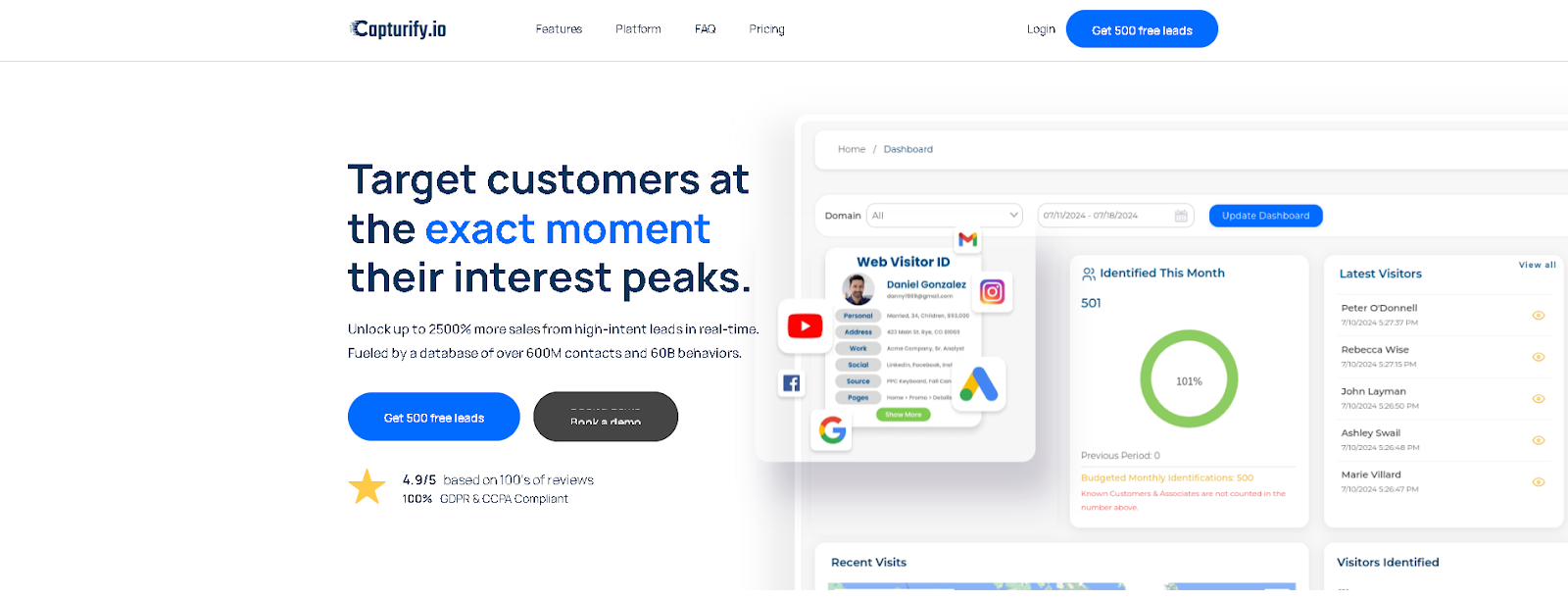Raw data alone won’t help you close deals or personalize outreach. It’s incomplete, outdated, and often full of gaps that weaken your marketing and sales performance.
That’s where lead enrichment comes in. By adding accurate, real-time details to your existing data, you turn a basic contact record into a complete, enriched customer profile.
If you’re unsure what that actually looks like in practice, we’ll share five data enrichment examples to learn from.
What Is Data Enrichment?
Data enrichment is the process of enhancing raw data by adding missing or updated information from internal and external data sources to ensure high data quality.
Rather than relying on incomplete or outdated records, you use data enrichment tools to improve data accuracy, fill gaps, and create a more comprehensive dataset.
The goal is to transform basic contact records, such as an email address or name, into detailed, enriched customer data that includes geographic, behavioral, and demographic data, as well as purchase history information.
Benefits of Data Enrichment
This enriched information gives sales and marketing teams what they need to engage with potential customers more effectively.
It also helps you maintain data integrity, reduce duplicate data, and make sure your customer data, sourced from relevant data sources, stays up to date across all channels.
What Types of Data Can Be Enriched?
To get the most out of your data enrichment efforts, it’s important to understand the different kinds of data that can be enriched, which include:
Contact Data
This includes names, email addresses, phone numbers, and job titles. Enriching contact data helps sales teams personalize outreach and avoid duplicate data or incomplete records in the existing database.
Demographic and Geographic Data
Adding demographic data like age, gender, income level, and geographic data (e.g., location or ZIP code) allows for targeted marketing and better segmentation of your audience.
Behavioral and Transactional Data
By pulling in behavioral data like website visits or product views and purchase history, you can build enriched customer data that reflects real-time intent and buying patterns.
Firmographic and Technographic Data
For business-to-business (B2B) brands, enriching your business data with firmographics (industry, company size, revenue) or technographics (what tools a company uses) can greatly improve data quality and alignment between sales and marketing teams.
Whether you’re working with customer profiles, sales records, or a basic data set, the goal of data enrichment is to add meaningful context and depth to existing data.
5 Real Data Enrichment Examples Across Business Functions
Whether you're in sales, marketing, support, or product, leveraging enriched customer data from internal and external sources helps drive smarter decisions and better outcomes.
Here’s how different teams can use the data enrichment process to improve performance and deliver results.
1. Sales: Enriching LinkedIn Leads With Accurate Contact and Company Data
If you're pulling leads from LinkedIn, you’re probably starting with just a name, job title, and company. Maybe you get lucky and find a location or industry, but that’s usually it.
On its own, this raw data won’t get you far. It doesn’t tell you how to reach the person, what they care about, or if they’re even a good fit.
How to Enrich This Data
To make those basic LinkedIn profiles actionable, you’ll want to layer on more context from both internal and external sources. That includes:
- Verified phone numbers and work emails
- Company size, revenue range, and headquarters location
- Any past interactions or purchase history from your customer relationship management (CRM) platform
- Website behavior like repeat visits or pricing page views
This turns a simple profile into a high-quality, enriched dataset you can actually work with.
What Techniques to Use
To perform data enrichment here, you’ll likely use:
- Deterministic and probabilistic matching to confirm identity across multiple touchpoints
- Data cleansing to fix missing, outdated, or duplicate fields
- Merging internal CRM data with third-party business databases
- Behavioral tracking to spot intent signals like clicks, downloads, or email opens
What Value It Produces
With enriched sales data, your sales team can:
- Prioritize leads based on buyer fit and readiness
- Craft more relevant outreach based on job role, industry, or stage
- Skip the research and spend more time actually selling
- Improve lead scoring and routing with more complete information
- Close deals faster by focusing on the highest-potential contacts
Bottom line? Enrichment helps your sales team generate more qualified leads, build better conversations, and win faster.
2. Marketing: From Anonymous Website Visit to Qualified Leads
You probably track how people interact with your site through page views, bounce rates, or clicks. But if you’re only seeing anonymous sessions, you’re missing out.
These visitors are showing interest, but without identities, you can’t follow up or personalize anything.
How to Enrich This Data
You can identify anonymous website visitors and turn them into qualified leads by connecting behavioral signals to real user profiles. This involves pulling from:
- First-party data like page visits, form fills, or email opens
- Third-party data sources that provide names, emails, job titles, or company info
- Demographic data such as industry, company size, or location
- Visitor behavior tied to cookies, device IDs, or IP addresses
Together, these enrich each visitor’s profile so you know who they are, what they care about, and whether they match your ideal customer.
What Techniques to Use
To enrich this kind of data effectively, you’ll want to use:
- Probabilistic matching to connect anonymous sessions with real people across devices
- Leverage an identity resolution platform to unify profiles from different visits and behaviors
- Data cleansing to remove duplicates and fill in gaps
- Demographic enrichment to add context like industry, job function, or buying stage
What Value It Produces
With enriched visitor data, your marketing becomes sharper and more personalized. You can:
- Launch targeted campaigns based on real user traits
- Create custom nurture journeys based on behavior and persona
- Improve conversion rates with messaging that actually resonates
- Build remarketing audiences that reflect real potential, not guesswork
This isn’t just about "more data." It’s about giving your marketing team the tools to engage the right people, at the right time, with the right message.
Sign up for Capturify for free and capture contact data from unidentified website visitors.
3. Customer Support: Adding Purchase and Location Data to Support Tickets
When a customer submits a support request, you typically receive the basics: their name, email, and a brief message. But that raw data doesn’t tell your support team much about who they’re helping or what they’ve experienced with your product.
Without context, it’s hard to personalize responses or resolve issues quickly, which makes effective data management challenging.
How to Enrich This Data
To turn a simple support ticket into a full customer view, you can enrich it by connecting to:
- Purchase history to understand what the customer bought and when
- Geographic location to route requests to the right reps or support center
- Product usage data to see what features they’ve used or where they might be stuck
- Support history to uncover prior issues or repeat questions
This helps your team engage with empathy and insight, not just scripts.
What Techniques to Use
Support teams often rely on:
- CRM integrations to link support tickets with existing customer profiles
- Data merging between helpdesk tools and order management systems
- Behavioral data tracking to spot usage patterns and common problem areas
- Identity resolution to tie together tickets submitted under different emails or devices
What Value It Produces
When you enrich your support data, you can:
- Personalize every interaction based on what the customer has done and bought
- Resolve tickets faster by giving agents the full picture up front
- Proactively recommend fixes or next steps based on usage behavior
- Improve customer satisfaction by making support feel seamless and intelligent
Ultimately, enriched customer data lets your support team respond with clarity and care, turning problems into loyalty.
4. Product Development: Contextualizing Customer Feedback With Behavioral and Demographic Data
When your product team reviews feature requests or customer feedback, they typically begin with raw data, such as in-app surveys, support tickets, or Net Promoter Score (NPS) comments. These inputs reveal what users say, but not who they are or how they actually use your product.
Without additional context, it’s hard to know which requests to prioritize or which users represent your most valuable segments.
How to Enrich This Data
You can turn raw feedback into actionable product insight by merging it with enriched customer profiles. This includes:
- Behavioral data like frequency of product usage, session duration, and most-used features
- Demographic data such as industry, company size, or role
- Purchase history to distinguish between free users and paying customers
- Churn risk indicators or renewal timelines to gauge urgency and impact
This enriched data helps you prioritize features based on actual product usage and customer value.
What Techniques to Use
To enrich your product feedback, apply techniques like:
- Linking support tickets or survey responses to behavioral analytics from product telemetry
- Associating feedback with user traits via CRM or customer data platforms
- Using deterministic and probabilistic matching to map feedback to customer records
- Segmenting requests by firmographics or feature adoption to detect trends
What Value It Produces
When you enrich product feedback with user context, your roadmap decisions get sharper. You can:
- Prioritize features based on usage trends and revenue impact
- Avoid building for edge cases by focusing on feedback from ideal customers
- Improve retention by solving real pain points for your most valuable users
- Collaborate better across product, marketing, and support teams using shared insights
Ultimately, enriched feedback allows for effective data cleansing by turning vague input into focused product development, so you’re building what matters for the customers who matter most.
5. Risk Management: Enhancing Internal Records With External Data for Smarter Risk Detection
If you work in risk management, your team likely starts with internal records: things like transaction logs, application data, account history, or support notes. While this internal data is crucial, it doesn’t always flag suspicious behavior on its own.
Without enrichment, especially from external sources, you’re often missing external risk signals, third-party validation, or behavioral anomalies that could indicate fraud or credit risk.
How to Enrich This Data
To make your risk detection process smarter, start by layering in:
- Third-party data from fraud databases, credit bureaus, or sanctions lists
- Geolocation details and device IDs to flag suspicious access patterns
- Behavioral signals from web sessions (e.g., rapid form fills and inconsistent keystrokes)
- External business or identity validation using public records or known risk indicators
By bringing in data from multiple external and internal sources, you get a broader view of both the individual and their risk profile.
What Techniques to Use
Effective data enrichment for risk management uses a combination of:
- Real-time matching against external risk databases
- Probabilistic models to identify outliers in behavior or application data
- IP address and device fingerprinting to detect fraud patterns
- Cross-referencing customer profiles using deterministic matching to validate identities
What Value It Produces
Enriched risk data helps you act quickly and confidently. You can:
- Flag high-risk accounts before fraud occurs
- Accelerate approval for trusted customers with verified records
- Reduce false positives that slow down operations or frustrate legitimate users
- Strengthen compliance by maintaining accurate audit trails and customer identities
With enriched data, your risk team doesn't just react to threats. You prevent them, while still offering a smooth customer experience.
Use Capturify to Continuously Enrich Your Data With Confidence

If your business relies on high-quality customer data to fuel sales, marketing, or product decisions, data enrichment is essential. But most companies struggle to maintain up-to-date data across multiple systems, let alone unify it into a single customer view.
That’s where Capturify comes in.
Capturify helps you collect data from existing systems and transform raw data into enriched customer insights. The platform’s identity resolution capabilities work across digital and offline channels to merge disparate data sources into a unified dataset.
From contact enrichment to customer behavior analysis, Capturify makes sure your team always works with accurate, relevant data.
Capturify doesn’t just patch missing fields. It preserves data integrity and enriches every profile in real time.
You can:
- Identify data sources that matter most to your business
- Merge internal data sources like CRM records with valuable external data sources
- Enrich web visitor profiles with over 40 unique data points, including contact details, firmographics, and behavioral signals
- Leverage enriched data to power smarter segmentation, personalization, and lead qualification
Whether you're looking to enhance existing datasets or need a continuous data enrichment process built into your operations, Capturify delivers deeper insights and better results, without compromising data privacy or data security.
Ready to stop relying on incomplete data and start driving real performance? Get started with 500 free leads now!
FAQs About Data Enrichment Examples
What is an example of data enhancement?
A common example of data enrichment is adding verified phone numbers, emails, or geographic data to customer records that originally only included names and job titles.
This enrichment process improves data quality and helps teams deliver more relevant messaging based on location, role, or behavior.
Which set of procedures is an example of data enrichment?
Examples of data enrichment techniques include data cleansing (to correct errors), merging data from different systems, and appending new data points from trusted third-party sources.
These steps help improve data accuracy, enable deeper insights, and allow teams to make better business decisions using enriched customer data.
What are five examples of data information?
Five common types of data used in the data enrichment process include:
- Contact data (emails, phone numbers)
- Demographic data (age, gender, income level)
- Behavioral data (website visits, content engagement)
- Geographic data (city, region, postal code)
- Purchase history (order frequency, value, categories)
Each of these data points plays a role in enriching customer profiles, improving data analytics, and powering high-impact business operations.
How does data enrichment help you manage your data better?
Data enrichment helps you take messy, outdated, or incomplete data and turn it into something useful. By adding new details to your existing data, like job titles, contact info, or behavioral insights, you improve how your data is organized and used.
This process makes your data management cleaner and more efficient. It also cuts down on manual cleanup, improves segmentation, and helps your team make faster decisions with enriched data that’s always up to date.






.avif)